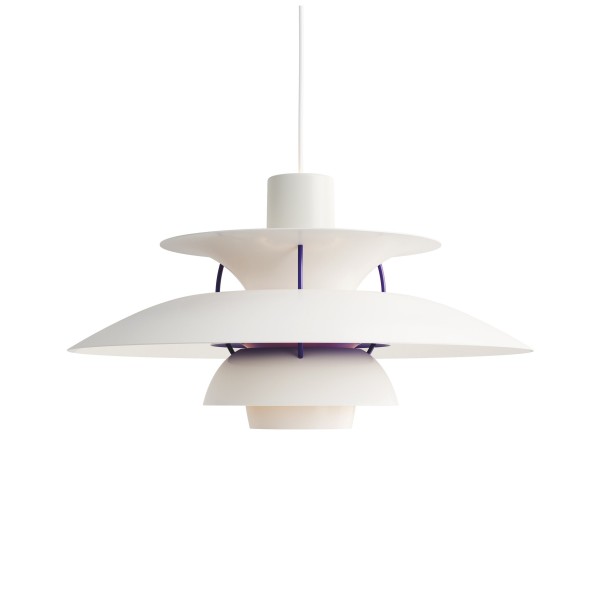PH5 – The design classic by Louis Poulsen
Louis Poulsen was founded in 1874, initially as a wine import company by Ludvig R. Poulsen, and is now known as a lamp specialist in Europe, Japan and the USA.
In 1892 Ludvig Poulsen opened a second company specialising in the sale of tools and electrical appliances. After his death in 1906 his nephew, Louis Poulsen, took over the company and in 1914 published his first catalogue of machines and tools. His partner, Sophus Kaastrup-Olsen, bought Poulsen's shares for 10,000 Danish crowns, and became the sole owner of Louis Poulsen & Co.
1924 the cooperation with the designer Poul Henningsen (1894-1967) started, because the Poulsen company wanted to present itself at the international fair for decorative arts and industrial design in Paris. Poul Henningsen's lamp was honoured there with the gold medal.
Two years later, in 1926, Louis Poulsen won the tender for a building in Copenhagen with the PH luminaires. Louis Poulsen began to market the luminaires internationally and transformed himself into a public limited company, which in 1941 acquired Laurits Henriksen Metallwarenfabrik to produce its own luminaires.
Henningsen also designed lighting for the Copenhagen Tivoli, which could not be seen by enemy aircraft.
1958, birth year of the PH5 luminaire
1958 saw the launch of the PH5 luminaire. The luminaire is designed in such a way that all types of lamps can be used, from simple Christmas tree candles to 100 watt lamps.
The number "five" refers to the 50 cm diameter of the lamp. In 1962 Louis Poulsen's first subsidiary outside Denmark was founded - in the Federal Republic of Germany.
Since 2008, on the occasion of the 50th anniversary of the lamp, Louis Poulsen has produced the designer lamp in new colours. Initially, the inside of the lamp was made of metal (later glass), but he coloured the models in white, gold or silver, depending on the desired lighting effect from warm to cold.
Henningsen sought glare-free light that was practical and decorative without casting harsh shadows.
The PH lamps are available as pendant and table lamps.
Famous designers at Louis Poulsen
Louis Poulsen worked not only with Poul Henningsen but also with famous designers such as Arne Jacobsen (1902-1971) and Verner Panton (1926-1998).
Arne Jacobsen stands for Danish design par excellence and Verner Panton entered the Design Olympics with the Panton Chair, which was named after him.
Louis Poulsen's most famous products include the PH lamps and the iconic PH Artichoke and PH Snowball lamps by Poul Henningsen, PH stands for the designer's initials.
The "PH Lamps" and pendants are often offered as fakes; originals can be recognised by the fact that the lamps are invisible.
Poul Henningsen
Poul Henningsen (1894-1967) was born in Copenhagen as the illegitimate son of the writers Agnes Henningsen and Carl Ewald.
He studied at the Technical School Frederiksberg and at the Technical College in Copenhagen without graduation.
At first he was interested in functional architecture, but soon concentrated on lighting design, for which he became famous.
Poul Henningsen worked with Louis Poulsen Lighting from 1925 until his death. Henningsen owed his mother's quest for beneficial light "that brings out beauty in the best possible way"; Henningsen dedicated his life to the study of glare-free light.
Only the Second World War interrupted his research and work as an architect at the Tivoli in Copenhagen; he fled to Sweden and wrote critical articles on art, architecture and the German occupation.
After the war, Poul Henningsen returned and in 1958 designed the "PH Artichoke" from 72 sheets for the Copenhagen beach restaurant "Langelinie" and the "PH Snowball".
Throughout his life he was interested in politics, but later turned away from socialism.
The design classic PH 5 by Louis Poulsen through the ages
The idea of the PH 5 lamp goes back to Poul Henningsen's desire to create 100 percent glare-free light and to be able to use many types of illuminants - due to the constant development of incandescent lamps. Over the decades, the PH 5 has been continuously adapted to the latest light sources.
The first PH luminaire for energy-saving lamps followed in 1994. For more brightness, the manufacturer switched from metal to glass and painted the luminaire white.
In 2008, the PH 5 celebrated its 50th birthday with a new series in high gloss and five new colours that conquered the market. This was followed in 2013 by four new, rather matt colours for a more discreet appearance.
The PH5 luminaire is now available from us.


